- Details
- Category: The collection
The museum is born in 1808 as the Gallery annex of the Academy of Fine Arts ("Accademia di Belle Arti"), founded from the old Clementine Academy. The core of the collection, from the Institute of Science, is enriched by the addition of a thousand of paintings from the abolition of male e female convents, churches, guild residences and religious educational institutes, due to the entrance of Napoleon French troops between 1797 and 1810.
The Pinacoteca saw a huge increase of extension both in space and artworks, due to the new abolitions made by the new Italian State, but also by new donations.
The major extensions was made in 1914/1920, when an entire wing was constructed (work of the Architect Edoardo Collamarini, under the direction of Francesco Malaguzzi Valeri), and in the 60s and 70s, with the realisation of the large Renaissance hall and the restructuring of the entrace hall with the two-flight staircase made by the Architect Leone Pancaldi under the direction of Cesare Gnudi, under the dome with the St. Ignatius Glory" of the Jesuit painter Giuseppe Barbieri.
The recommended itinerary starts with the expressive strenght of the Bolognese and Emilian artists of the XIII and XIV centuries, such as Vitale da Bologna, the Master of Bologna Polyptychs, and SImone dei Crocefissi, not to mention the considerable exemple of the Giotto polyptych. For this period of the Bolognese art is important the room which hosts the frescoes from the S. Maria di Mezzaratta church, reassembled according to the original architectural structure.
The Renaissance is featured by the Ferrarese Francesco del Cossa with his "Merchants Altarpiece" and Ercole Roberti with a small fragment depicting the Magdalene, from the Garganelli chapel of the St. Peter church, and by the Bolognese Francesco Francia, with several Altarpieces.
Starting from the Raphael's masterpiece ’”Extasis of St. Cecily” the itinerary reaches, after the Parmigianino painting of St. Margaret Altarpiece and the Passerotti - to the Reform of the late XVI century, with the work of the Carracci, among which we can stress the importance of the “St. Jerome Last Communion” by Agostino, the “St. Louis Altarpiece” by Annibale, the ’”Annunciation” and the “Bargellini Madonna” by Ludovico.
Then you can find the masterpieces of the Emilian Baroque, with the Guido Reni artworks, the “Massacre of the Innocents" and the so-called “Plague Altarpiece”; the three exceptional Domenichino Altarpieces depicting "The St. Agnes Martyrdom", the "Rosary Madonna" and the "St. Peter Martyr"; the Francesco Albani "Baptism of Christ", the Alessandro Tiarini “Entombment of Christ”, “St. Sebastian cured by Irene” and the Guercino "St. William receiving the Cow" .
The itinerary ends with the 18th century, with its various aspects - sometimes popular, sometimes aristocratic - of Giuseppe Maria Crespi (with his “Farm scene” and the "Self-Portrait"), Donato Creti (the two "Allegorical Tombs") and of the Gandolfi brothers, Gaetano and Ubaldo.
- Details
- Category: The collection

As of 1 July 2024 Palazzo Pepoli Campogrande is closed to the public for renovation and function-related upgrading. It is scheduled to reopen in spring of 2026.
Palazzo Pepoli-Campogrande is the satellite-seat of the Pinacoteca Nazionale, and is known even under the name of "Palazzo Pepoli Nuovo” (New), to differentiate it from the "Old" Palace, i.e. the XIVth century Home of the Pepoli family, just on the opposite side of the road. Built from the second half of the XVIIth century on behalf of Odoardo Pepoli, the new palace was intended as a modern and rich residence, appropriate to represent the social role of the family that, starting as textile merchants, and then money-changers and bankers, have become one of the most richest and important family of Bologna .
The building of the Palace began with the monumental staircase, large and elegant, conceived as a perfect set design for the elaborate ceremonial of the Baroque aristocratic society, that connects directly the entrance with the main floor. On tha vault, framed by rich stucco decoration, can be seen two oval frescoes by Domenico Maria Canuti (1665), depicting Taddeo Pepoli named Lord of Bologna and Taddeo Pepoli confirmed as vicar apostolic by the Pope.
The main floor, donated by Edvige Campogrande to the Bologna Municipality, and now managed by the Polo Museale dell’Emilia Romagna, houses a series of wonderful rooms frescoed by the main protagonits of the Bologna decoration painting, from the hal of the XVIIth century up to the beginning of the next century. Starting from the Main Hall with the triumphant Hercules' Apotheosis by Canuti, to the Felsina Room, with the gracious and well composed figures made by the Rolli brothers; from the Seasons and the Olympus rooms, where the playful Giuseppe Maria Crespi mixes up the the celebratory decoration with the genre painting ways, up to the elegant classicism of the Alexander Room by Donato Creti.
The spaces of the main floor house some of the paintings of the Zambeccari Collection, the rich collection donated at the end of the XVIII century by the Marquess Giacomo Zambeccari which enterd in the Pinacoteca collections in 1884.
- Details
- Category: The collection
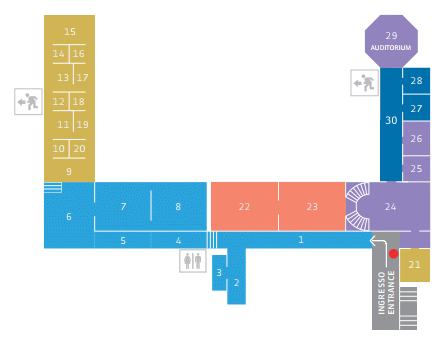
ROOMS CAPTION
- Details
- Category: The collection
The Pinacoteca Nazionale di Bologna, together with the Fine Arts Academy is located in the building of the former Jesuitic Novitiate Convent and the Church of St. Ignazio, builded between 1728 and 1735 following the project of the bolognese Architect Alfonso Torreggiani. After the entering of the Napoleon army in Bologna (1796), and the soppression of many religious Orders, the Clementine Academy, with the new name of Fine Arts Academy, begins to collect the many artworks from the abolited orders, and their increasing number will lend to the moving of the collections from Palazzo Poggi, that became the seat of the Bologna uNiversity, to the nearby St. Ignazio Convent.
The entrance of the museum is located where was the original convent chapel: in the vault is still visibile the fresco with the St.Ignatius Glory, of the jesuit painter Giuseppe Barbieri, an Andrea Pozzo pupil.
In the inner court there is a sandstone Tank, realised by Francesco Morandi called the Terribilia in 1587, here transferred from the e trasferita nel 1886 dal Giardino dei Semplici del Palazzo Comunale, in occasione dei lavori di costruzione dell’attuale Sala Borsa.
Subcategories
Room 1: From the XIIIth century to the Gothic style
This rooms hosts some Bolognese and Emilian artworks of the XIIIth and XIVth centuries: from Vitale da Bologna (documented since 1330 - dead before 1361) which with the expressive strength of his paintings marks the Emilian XIVth century art, in opposition to the well-measured elegance of the Tuscany production of the same age, up to the so called "Maestro dei Polittici bolognesi" (or Psudo-Jacopino), a bolognese painter working between 1320 and 1330, with his strongly narrative style, so distant from the abstract manner of the religious representation of the time.
The exposition begins with a Crucifix from the Santa Maria del Borgo church, artwoks attributed to an unknown artist close to Giunta Pisano; continues prosegue with the Vitale da Bologna's St. George and the Dragon, and with other paintings of the same artist, up to the polyptich with the Dormitio Virginis and the one with the Presentation at the Temple by the "Maestro dei Polittici bolognesi".
Room 2: The Gothic style
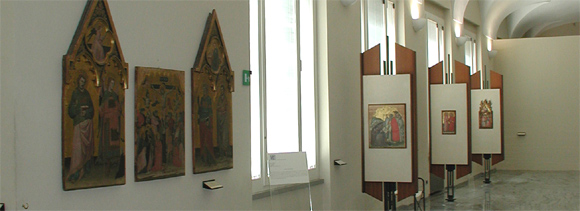
In this room are showed artwork by painters of the second half of the XIVth century, when the gothic expressiveness becomes less extreme.
Besides some works of Simone de’ Crocefissi and Jacopo di Paolo, author of the monumental wooden altar in the Bolognini chapel in St. Petronius church, we find the Crucifix by Giovanni da Modena, author, in the same chapel, of the large fresco cycle with the Stories of the three Kings and the Last Judgement (both still visible on the spot).
To this last scene is connected the wooden table here exposed with the Paradise and Hell, maybe made by a miniaturist close to Giovanni himself.
Room 3: Giotto and "the foreigner painters" in Bologna
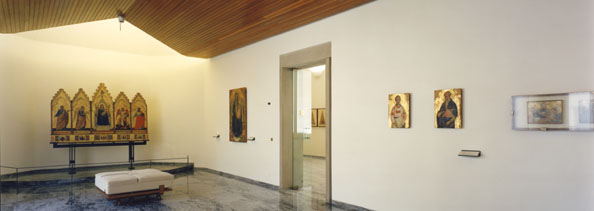
In this room are exposed some important painting of schools outside Bologna.
The most important work is the polyptich made by Giotto for the Santa Maria degli Angeli church: the only signed by the Florentine master in Bologna, unica opera firmata del maestro fiorentino a Bologna, usually dated to 1330 circa.
Beside this artwork, it can be found others Umbrian and Tuscan works, like the Crucifix of Rinaldo di Ranuccio, signed and dated 1265, the Last Supper of the senese Andrea di Bartolo, an interesting small wood table of an anonymous florentine called Maestro della Misericordia which in the second half of the XIVth century seems to be aware of the new Giotto style, and a Madonna with Child by the late gothic Florentine painter Lorenzo Monaco.
Room 9: The XVth century painting and the Humanist studies
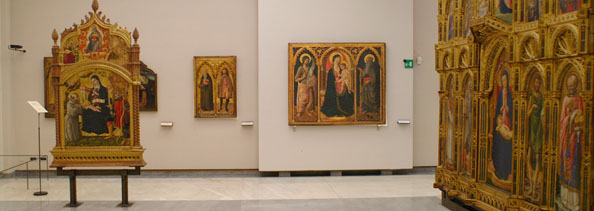
The Renaissance section begins with this room, starting from the large Polyptich signed in 1450 by the Murano painters Antonio and Bartolomeo Vivarini, representative maters of the Venetian school.
Antonio Vivarini is also the author of the Jesus Christ emerging from the tomb, one of the most important proof of the Vivarini presence in Emilia.
On the same wall, in the left of the entrance, you can see the Madonna with Child by Cima da Conegliano, and the processional banner by Niccolò Alunno, depicting on one side the Madonna with Child ans Saints and on the other one the Announciation dated to 1482.
Room 10: The art at the Bentivoglio court
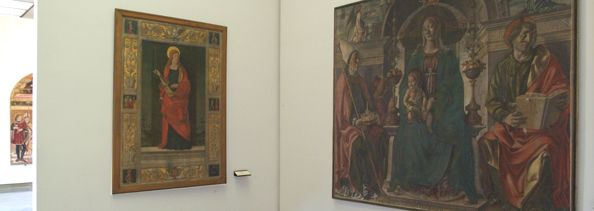
In this room we see the artistic production of the early Bolognese Renaissance, with the Madonna enthroned with Child with St. Petronius and John Evangelist adored by the donor Alberto Cattani aka Merchants Altarpiece, (1474) by Francesco del Cossa, which occupy the entire right wall.
On the opposite wall are displayed a small wood table with Saint Michael Archangel, by Ercole de’ Roberti and, of the same artist, the preciuos fragment with Mary of Magdalen crying, the only surviving pating of the famous decoration of the della Garganelli Chapel in the St. Peter Church, begun by del Cossa and finished by Ercole (1479-1483), then destroyed at the end of the XVIth century.
Room 11: The art at the Bentivoglio court

In this large room are on displey some of the most important artworks of the ferrarese painter Lorenzo Costa, coming from Bolognese churches: the Madonna enthroned with Child and Saints Petronius and Tecla, aka Saint Tecla Altarpiece, in the namesake church, one of his first experience with classicism, and the St. Petronius with the saints Francis and Dominic, from the Annunziata church.
Even the Assumpted Madonna from Monteveglio Abbey, a temper on canvas from the 1590's.
In this room can be found even a painting of the Ferrarese Sebastiano Manieri depicting Saint Sebastian, the Baruffino Portrait by Giovan Francesco Maineri and a painting by some member of the Lendinara entourage.
Room 13: The art at the Bentivoglio court

In this room, together with the previous one, are displayed the artworks of Francesco Francia, the most important painting at the Bentivoglio court the Bentivoglio Altarpiece and the Manzuoli Altarpiece.
Room 15: The central Italy art and Raphael
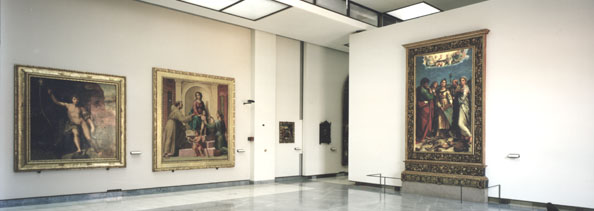
This room displays two large altarpieces, both made for the San Giovanni in Monte church in Bologna, one of the favorite place of the new Patronage of the early '500, and that cause a long echo on the following years: the Madonna with Child in Glory with saints John the Evangelist, Pollonia, Catherin of Alexandria amd Michale Archangel by Perugino and the Extasis of St. Cecilia by Raphael.
Together with this masterpieces of the central Italy Classicism, we find other paintings, bounded to the Tuscan Classic culture of the early XVIth century, with which the artist of the new Bolognese school will interact more or less strictly.
Room 18: Parmigianino and Bologna
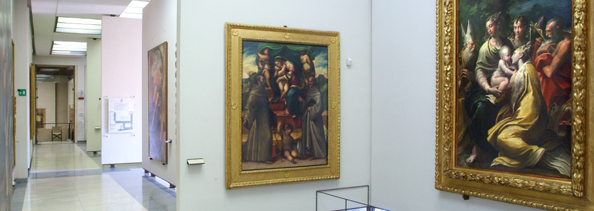
This room is dedicated mainly to the Madonna with Child and Saints Margaret, Hyeronymus and Petronius (1529) by the Parmigianino, an artworks where the formal elegance and the ambivalent expression of mannerism are wonderfully combined.
Girolamo da Cotignola, remembered with his Bolognese fellows in the church of San Michele in Bosco and in several locations open in Bologna at the begnning of the XVIth century, is here represented with his Madonna with Child, St. John the Baptist and Bermard, where it can be found elements by Raphael, and of Venice and Bologna school, and the large altarpiece with the Marriage of the Virgin, with its altar-step with the St. Joseph's Dream, Jesus' Birth and Flee into Egypt, Sogno di San Giuseppe. Natività di Cristo. Fuga in Egitto, in which raphael style, central-Italy memories and Bolognese culture are united in one of the most complex results of his art.
Room 20: Northern Italy Mannerism - Venice and Genua
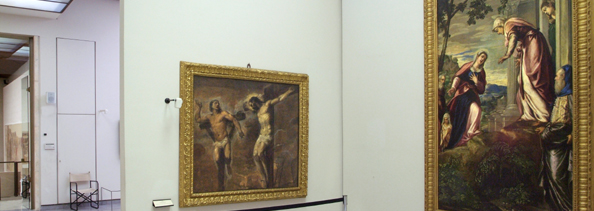
This room, that ends the Renaissance area, hosts interesting works of Venetian school, as the Mourning on Christ Body by the Paduan painter Domenico Campagnola, the Visitation by Tintoretto, important artwork for the formation of the young Carraccis and the Crucified Jesus with the Good Thief, by the late Titian.
The Adoration of the Shepherds, painted for Bologna by the Genuan painter Luca Cambiaso, is the sign of the several exchanges and confrontation of that time, wich formed the basis for the further development of the new Bolognese experience of the following years.
Room 22: The Late Mannerism
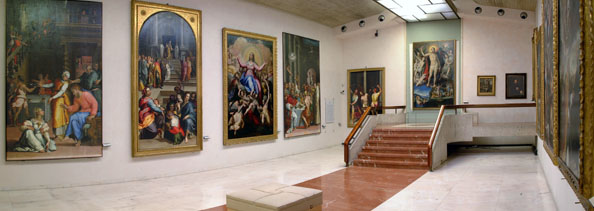
In this room are exposed works realised in the second half of the XVIth century, that are therefore prior or contemporary to the naturalist Carraccis revolution, maintening in their compositiion a strict adherence to the Mannerist style.
Artworks by artist such as Giorgio Vasari, Camillo Procaccini, Prospero Fontana and Bartolomeo Passerotti, an important protagonist of the late Bolognese Mannerism, in which a penchant for naturalism is a divresion from the intellectual schemes of that period.
The severe composition and the devotional faith of Bartolomeo Cesi's painting are the introdoction to the following room, dedicated to the Carracci family.
Room 23: the Carracci
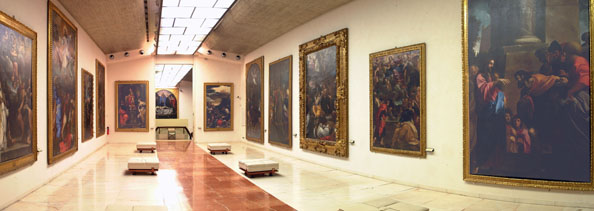
In this large room are on display some of the most important artworks by Ludovico (1555-1619), Annibale (1560-1609) and Agostino Carracci (1557-1602), Founders in the 1580's of the Incamminati Academy.
This was a school / workshop in which the new art ideas of the three cousins, matured by the union of the "true" lessons with the study of the great "Cinquecento" masters (mostly Correggio, Titian and Veronese), could be practise and teached to the youngster pupils.
The intention was that of reforming the painting of their age, with a return to a more Nature inspired art.
By Ludovico, great interpreter of both the high spirituality of the Counter-Reform as of the simplicity of everyday life, there are some paintings marking some of the highest achievements of his career, like the Announciation and the Preaching of St John the Baptist.
Few are the artworks by Annibale who left Bologna in 1595, summoned to Tome by the Cardinal Odoardo Farnese in order to wotk at the fresco decoration in the Camerino and in the Gallery of Palazzo Farnese.
At the end there are the only two paintings by Agostino, cultivated theorist of the Academy and well known as an engraver: the Assumption of the Virgin and the Last Communion service of St. Jerome.
Room 24: Guido Reni, "The divine"

This large room hosts the marvellous Guido Reni (1575-1642), best expression of the Classical ideal of the XVIIth century.
When Reni was still a child, he entered in the workshop of the flamish painter Denys Calvaert, of which he was pupil for ten years, reaching an high level of importance in that workshop.
In 1594 Guido left Calvaert to enter in the Incamminati Academy, where his talents were appreciated by Ludovico Carracci of which he became pupil and then rival.
The execution of the fresco for the entering in Bologna of the Pope Clemens Clemente VIII Aldobrandini (1598), was the beginning of a brilliant career that lead him in Rome in 1601, where he lived albeit with several interruptions, until 1614.
In the circle of the Papal court, he received important contracts.
The suggiostions from the ancient roman scupture, with Raphael and the classical language used in Rome by Annibale Carracci, lead Guido into an ever more profound "ideal" representation of reality. This continuous impulse towards the "ideal beauty" was the constant note in all the developmente of his career, which ended with artworks almost misterious, where the quality of the bodies loses weight and acquires a supernatural lightness.
In this room are displayed the most improtant paintings realised in Bologna, in a succession that retrace all the stages of his artistic life.
Room 25: The painters of the Carracci's "Incamminati" Academy

In the first room of this corridor there are on display artworks of the artists of the Carracci's workshop of the Incamminati Academy.
Among those, there is the Mourning on the dead Christ's body (1617), one of the most convincing achievements of Alessandro Tiarini, the Prodigal Son by Lucio Massari, and, again by Tiarini the Mystic marriage of St. Catherine and the altarpiece by (Madonna with Child in Glry woth the saints Eligius and Petronius)
Before leaving the room, it can be admired the beautiful Announciation by Pietro Faccini, colourful and elegant artwork.
Room 26: The Classicism
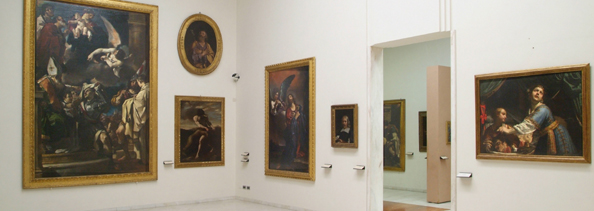
Questa sala presenta una panoramica sull’arte di Giovan Francesco Barbieri detto il Guercino, universalmente riconosciuto e apprezzato come uno dei massimi esponenti del seicento bolognese.
Sono qui esposti alcuni importanti dipinti tra i quali riveste un ruolo preminente il San Guglielmo d'Aquitania che riceve l'abito religioso da San Felice Vescovo (Vestizione di San Guglielmo), capolavoro giovanile realizzato nel 1620 per la chiesa di San Gregorio.
La sua ricca scuola, attiva per diverse generazioni, viene illustrata in modo significativo da un Ritratto attribuito a Benedetto Gennari, parente stretto e seguace del maestro.
Da segnalare è la presenza della Madonna col Bambino e San Giovannino e di Sant’Antonio da Padova in adorazione del Bambino di Elisabetta Sirani conosciuta interprete femminile del classicismo reniano.
Compaiono inoltre opere di Simone Cantarini, Giovanni Lanfranco e il Martirio di San Pietro da Verona (1619-1621) del Domenichino, derivata dal celebre dipinto di Tiziano andato distrutto nel 1867.
This room hosts an overview of the art of Giovan Francesco Barbieri called the Guercino, one of the most important painter of the Bolognese school of the XVIIIth century.
Here are exposed some important paintings, among which the St. Wilhelm of Aquitaine receiving the religiuos vest from St. Felix (Drerssing of St. Wilhelm), masterpiece of the earlier years, realised in 1620 for the St. Gregory church.
His workshop, active for many generations, is here represented by a Portrait attributed to Benedetto Gennari, relative of Guercino and his follower.
It is interesting even the Madonna with Child, and Saints John the Baptist and Anthony of Padua in adoration by Elisabetta Sirani, well known female interpreter of the Reni classicism.
On display we find works by Simone Cantarini, Giovanni Lanfranco and the Martirdom of St. Peter of Verona(1619-1621) by Domenichino, derived from the famous painting by Titian, destroyed in 1867.
Room 29: Large Size Altarpieces
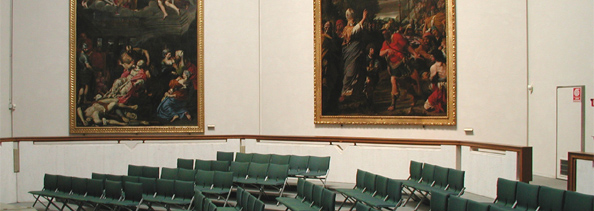
This large octagonal room, dedicated to the memory of the Great art historian Cesare Gnudi (1910-1981), for many years Director of the Pinacoteca, hosts usually the learning activities of the museum (concerts, lectures, speeches).
On the walls are displayed some large altarpieces of the most important era of the Bolognese school.
We find Ludovico Carracci with his “Birth of the Baptist”; Domenichino with a “Prayer-beads Madonna” and an altarpiece depicting the “Martyrdom of St. Agnes”; Francesco Albani, author of a “Baptism of Christ” and of the “Madonna with Child and Saints John the Baptist, Francis and Matthew”.
Furthermore, two artworks by painters not already represented in the museum: the large canvas with “Abraham and Melchisedech” by Lionello Spada, already pupil of the Incamminaty Academy since its foundation and then at works with Ludovico and the “Madonna with Child and Saints Theresa, John and Charles Borromeo” by Carlo Cignani, member of a generation that, in the middle of 1600's has acquired the innovation of the Carraccis.







